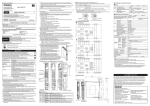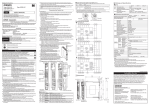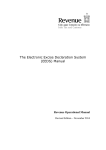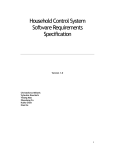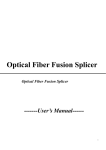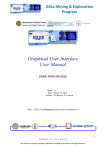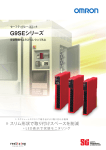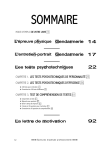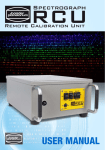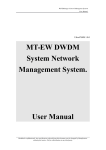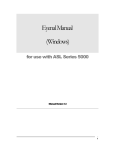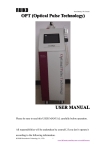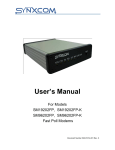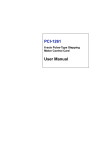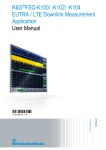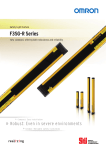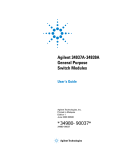Download Prototype User Manual
Transcript
OWNER: ISSUE DATE: VERSION: EMCS Business Prototype 28/04/2004 EMCS Business Prototype EXCISE SYSTEM SPECIFICATIONS PRODUCTION, MAINTENANCE AND SUPPORT, COORDINATION AND INFORMATION PROGRAM (LOT ESS) SUBJECT: Framework Contract EMCS Business Prototype EMCS Business Prototype User Manual EMCS Business Prototype DG TAXUD: EMCS COMPUTERISATION PROJECT EMCS BUSINESS PROTOTYPE USER MANUAL REF: EMCS PROTOTYPE VER: EMCS PROTOTYPE BUSINESS BUSINESS [Blank for duplex printing] ECP1-ESS-PUM-V2.00-Prototype User Manual_.doc Page 2 of 28 DG TAXUD: EMCS COMPUTERISATION PROJECT EMCS BUSINESS PROTOTYPE USER MANUAL REF: EMCS PROTOTYPE VER: EMCS PROTOTYPE BUSINESS BUSINESS Document History Edi. Rev. Date Description Action (*) Pages 1 pre00 20/09/2004 First version created I All 1 pre01 05/10/2004 QA Internal Review I/R All 1 pre02 01/11/2004 Implementation of comments (Submitted for Review) R All 1 00 02/12/2004 I/R All 2 pre00 04/04/2005 I/R All 2 pre01 19/04/2005 Implementation of DG TAXUD comments (Submitted for Acceptance) Internal Review: • Actors and Roles (4.2) • Scenarios (4.3) • Control the storyboard (5.2) • Using the FESS index (5.3) Implementation of DG TAXUD comments I/R All 2 00 28/04/2005 Submitted for Acceptance R All (*) Action: I = Insert R = Replace TABLE OF CONTENTS Document History.............................................................................3 1Introduction............................................................................................... 6 1.1Purpose...............................................................................................................6 1.2Field of Application...........................................................................................6 2Reference and Applicable Documents.....................................................7 2.1Reference Documents........................................................................................7 2.2Applicable Documents...................................................................................... 8 3Terminology...............................................................................................9 3.1Abbreviations and Acronyms...........................................................................9 3.2Definitions.......................................................................................................... 9 4Overview.................................................................................................. 10 4.1General principles........................................................................................... 10 4.2Actors and Roles..............................................................................................11 4.2.1Consignor..............................................................................................11 4.2.2Consignee............................................................................................. 11 ECP1-ESS-PUM-V2.00-Prototype User Manual_.doc Page 3 of 28 DG TAXUD: EMCS COMPUTERISATION PROJECT EMCS BUSINESS PROTOTYPE USER MANUAL REF: EMCS PROTOTYPE VER: EMCS PROTOTYPE BUSINESS BUSINESS 4.2.3MSA at dispatch................................................................................... 11 4.2.4MSA at destination............................................................................... 11 4.2.5MSA at transit.......................................................................................11 4.2.6Common Domain Central Services...................................................... 12 4.2.7Other actors...........................................................................................12 4.3Scenarios.......................................................................................................... 13 4.3.1Movements between warehouse keeper and non registered trader.......14 4.3.2EWSE and EMCS.................................................................................15 4.3.3Management of SEED data...................................................................15 4.3.4Management of reference data..............................................................16 4.4Storyboard....................................................................................................... 17 5.1Activate a scenario.......................................................................................... 21 1.1.1Perform actor’s action...........................................................................23 5.2.1Return back to the history..................................................................... 24 5.2.2Control the animation level.................................................................. 24 5.3Using the FESS index......................................................................................25 ECP1-ESS-PUM-V2.00-Prototype User Manual_.doc Page 4 of 28 DG TAXUD: EMCS COMPUTERISATION PROJECT EMCS BUSINESS PROTOTYPE USER MANUAL REF: EMCS PROTOTYPE VER: EMCS PROTOTYPE BUSINESS BUSINESS TABLE OF FIGURES Figure 1: Storyboard (map)..................................................................... 17 Figure 2: Storyboard (scenario start-up)................................................18 Figure 3: Storyboard (Actor’s state)....................................................... 19 Figure 4: List of actors..............................................................................19 Figure 5: List of entities............................................................................19 Figure 6: Prototype launching (welcome page)......................................20 Figure 7: Activate a scenario....................................................................21 Figure 8: Control the storyboard............................................................ 22 Figure 9: Control the storyboard (Actor’s action).................................23 Figure 10: Control the storyboard (history)...........................................24 Figure 11: Control the animation level................................................... 24 Figure 12: Message exchanges................................................................. 24 Figure 13: Actor’s animations................................................................. 24 Figure 14: FESS Index..............................................................................25 Figure 15: Flow diagram.......................................................................... 26 Figure 16: FESS Index (applicable scenarios)........................................26 TABLE OF TABLES ECP1-ESS-PUM-V2.00-Prototype User Manual_.doc Page 5 of 28 DG TAXUD: EMCS COMPUTERISATION PROJECT EMCS BUSINESS PROTOTYPE USER MANUAL REF: EMCS PROTOTYPE VER: EMCS PROTOTYPE BUSINESS BUSINESS Table 1: Reference documents................................................................... 7 Table 2: Applicable documents..................................................................8 Table 3: Abbreviations and Acronyms..................................................... 9 Table 4: Definitions..................................................................................... 9 Table 5: Movements between warehouse keepers/registered trader (Use Cases)......................................................................................... 14 Table 6: Movements between warehouse keeper and non registered trader (Use Cases)............................................................................. 15 Table 7: EWSE and EMCS (Use Cases)................................................. 15 Table 8: Management of SEED data (Use Cases).................................. 16 Table 9: Management of reference data (Use Cases)............................ 16 5 ECP1-ESS-PUM-V2.00-Prototype User Manual_.doc Page 6 of 28 DG TAXUD: EMCS COMPUTERISATION PROJECT EMCS BUSINESS PROTOTYPE USER MANUAL REF: EMCS PROTOTYPE VER: EMCS PROTOTYPE BUSINESS BUSINESS USING THE EMCS BUSINESS PROTOTYPE 1 Introduction 1.1 Purpose Prototype User Manual describes how to use the EMCS Business Prototype. 1.2 Field of Application This Prototype User Manual is applicable to prototyping activities undertaken by DG TAXUD in the context of Excise System Specifications (ESS), and in particular the functional stage in order to support the elaboration of the Functional Excise System Specifications [R2]. ECP1-ESS-PUM-V2.00-Prototype User Manual_.doc Page 7 of 28 DG TAXUD: EMCS COMPUTERISATION PROJECT EMCS BUSINESS PROTOTYPE USER MANUAL REF: EMCS PROTOTYPE VER: EMCS PROTOTYPE BUSINESS BUSINESS USING THE EMCS BUSINESS PROTOTYPE 2 Reference and Applicable Documents 2.1 Reference Documents Ref. R1 R2 R3 Identifier ECP1-ESS-PIG ECP1-ESS-FESS ECP1-ESS-GLT Title Prototype Installation Guide Functional Excise System Specifications Glossary of Terms Version V2.00 V1.00 V1.01 Issued 28/04/2005 18/04/2005 14/11/2004 R4 3AT 05006 AAAA CRZZA Feasibility Study – consolidated report V01 12/10/1999 R5 3AT 05006 AAAA DTZZA Feasibility Study – final report V02 19/11/1999 R6 CED Nr. 394 Addendum to the Feasibility Study Rev1 29/01/2003 R7 CED Nr. 474 Report by the Reflection Group R8 ECP1-ESS-GLT Glossary of Terms 1.01-EN 14/11/2004 R10 ECP1-ESS-FRS Fall-back and Recovery Specification V0.03-EN 01/10/2004 R11 TSS-FSF-REL4 Functional transit System Specifications V 4.0-e V 4.0-e 28/08/2001 R12 ECP1-ESS-INP Information Policy 2.03 22/12/2004 R14 ECP1-ESS-TOC Terms of Collaboration 2.03 03/12/2004 R15 CED Nr. 333 SEED DATABASE Rev 3 31/07/2001 R16 CED Nr. 457 Administrative arrangement for the use of the Early Warning System final 02/07/2004 R17 CED Nr. 329 Request for verification of intracommunity movements of excise goods Rev. 7 15/11/2002 R18 ECP-FITSDEVSA02-SEEDV0FSS Functional Excise System Specification for SEED V.0 0.5 25/01/2005 16/06/2004 Table1:Referencedocuments ECP1-ESS-PUM-V2.00-Prototype User Manual_.doc Page 8 of 28 DG TAXUD: EMCS COMPUTERISATION PROJECT EMCS BUSINESS PROTOTYPE USER MANUAL REF: EMCS PROTOTYPE VER: EMCS PROTOTYPE BUSINESS BUSINESS USING THE EMCS BUSINESS PROTOTYPE 2.2 Applicable Documents Ref. Identifier Title Version Issued A1 CED No 382 ECP Project Management Plan 3.00 Rev2 29/01/2003 A2 CED No 431 ECP Master Plan Rev 1 28/11/2003 A2 92/12/EEC Council Directive on the general arrangements for products subject to excise duty and on the holding, movement and monitoring of such products 25/02/1992 A4 (EEC) No 2719/92 Commission Regulation on the accompanying administrative document for the movement under duty-suspension arrangements of products subject to excise duty 11/09/1992 A5 (EC) No 31/96 Commission Regulation on the excise duty exemption certificate 10/01/1996 A6 (EC) No 2073/2004 Council Regulation on administrative cooperation in the field of excise duties 16/11/2004 Table2:Applicabledocuments ECP1-ESS-PUM-V2.00-Prototype User Manual_.doc Page 9 of 28 DG TAXUD: EMCS COMPUTERISATION PROJECT EMCS BUSINESS PROTOTYPE USER MANUAL REF: EMCS PROTOTYPE VER: EMCS PROTOTYPE BUSINESS BUSINESS USING THE EMCS BUSINESS PROTOTYPE 3 Terminology 3.1 Abbreviations and Acronyms AAD BPR COL EC ELO EOL EMCS ESS EWSE FESS MA MSA MVS ORO SEED Administrative Accompanying Document Business Prototype (or FESS Prototype) Customs Offices List European Commission Excise Liaison Officer Excise Offices List Excise Movement and Control System Excise System Specifications project Early Warning System for Excises Functional Excise System Specification Mutual Assistance Member State Administration Movement Verification System Occasionally Registered Operator System of Exchange of Excise Data Table3:Abbreviationsand Acronyms 3.2 Definitions Actor Excise System Specifications project (ESS) Entity Role Scenario Use Case Defines someone (people or application) involved in the EMCS. Each one plays specific role in various use cases. The Excise System Specifications project (ESS) is the phase 1 of the Excise Computerisation Project (ECP) that aims at setting up the Excise Movement and Control System (EMCS). An entity is a piece of information, either very elementary or complex, that is used to build the information exchange messages. Defines actor’s responsibility and motivation for the various use cases. Scenario defines particular context where EMCS is used (e.g.: movement between registered traders, EWSE, etc.). A complete sequence of related actions initiated by an actor to accomplish a specific goal; it represents a specific way of using the system. It describes a process by which actors do things that lead to the need for information interchange. A use case contains also all alternate flows of events related to producing the observable result. Table4:Definitions ECP1-ESS-PUM-V2.00-Prototype User Manual_.doc Page 10 of 28 DG TAXUD: EMCS COMPUTERISATION PROJECT EMCS BUSINESS PROTOTYPE USER MANUAL REF: EMCS PROTOTYPE VER: EMCS PROTOTYPE BUSINESS BUSINESS USING THE EMCS BUSINESS PROTOTYPE 4 Overview This guide aims at presenting the EMCS Business Prototype. It leads you through the process of understanding principles and symbols. Among all the symbols which appear in the prototype, the following icons indicate various types of links: Normal link. It denotes branching to another part of the prototype. Link to help. It appears when a contextual on-line help is available. Link to a FESS reference. It appears when a reference to the FESS is available. 4.1 General principles The EMCS Business Prototype is not a pre-version of the target system. It is didactic material that assists the readers of the EMCS Functional Specification. It is a simulator that shows what the system will do. The aim for prototyping EMCS services during the specification phase is to support the specification methodology and to validate the various options elected. The FESS Prototype (or BPR - Business Prototype) consists in the functional stage of the EMCS Prototyping. It illustrates the global understanding of functional demands and its purpose is to demonstrate users how the target system could behave. The general principle of the prototype is that it is driven by scenarios (see section 4.3 Scenarios). A scenario puts the prototype context under certain conditions in order to simulate specific situations (use cases as described in the FESS [R2]). A scenario defines actors (see section 4.2 Actors and Roles) that play roles and applications that execute processes. Those processes manipulate entities (e.g. e-AAD, temporary authorisation, etc.) that exist according to life cycles. The EMCS Business Prototype gives the vision of the various actors on the future system. It shows how they can act and when (states). Therefore, the prototype highlights: • The manipulated entities, their content and their life cycle; • The involved actors, their roles and their capabilities (states) regarding a particular scenario; • The automated applications, their behaviour through the various processes they must implement; • The exchanged messages. There are two different ways to use the EMCS Business Prototype: • Select and play a scenario (see section 5.1. Activate a scenario) and consult the FESS through the BPR FESS Index (see section 5.3. Using the FESS index) for more details about a particular use case; • Read the FESS documents and use the BPR FESS Index (see section 5.3 Using the FESS index) to know which scenario is relevant to illustrate a particular use case. The “HELP” page provides another entry point. It describes the scenarios and actors, and provides links to the various implemented use cases and elementary business processes. ECP1-ESS-PUM-V2.00-Prototype User Manual_.doc Page 11 of 28 DG TAXUD: EMCS COMPUTERISATION PROJECT EMCS BUSINESS PROTOTYPE USER MANUAL REF: EMCS PROTOTYPE VER: EMCS PROTOTYPE BUSINESS BUSINESS USING THE EMCS BUSINESS PROTOTYPE 4.2 Actors and Roles The following sections describe the major roles involved in the system. 4.2.1 Consignor The consignor submits the AAD and all possible changes: cancellation with or without replacement, update, splitting, chaining, etc. The consignor is the owner of the content of an AAD, i.e. he or she is the only one allowed to change its content. 4.2.2 Consignee The consignee reports receipt or refusal of goods, warns on non-conformity of documents. Note: the prototype does not implement the” take away” use cases. 4.2.3 MSA at dispatch MSA Dispatch application validates all information submitted by the consignor, in particular all successive states of the AAD. Then, it registers the e-AAD, assigns an ARC to it and sends the information to all MSA applications concerned. 4.2.4 MSA at destination MSA Destination application forwards, as far as possible, information to the consignee and possibly to the tax representative, then formally validates the report of receipt and transfers it to the MSA Dispatch system; monitors incoming traffics, i.e. the goods entering into a tax warehouse. 4.2.5 MSA at transit MSA Transit application (in some other Member State involved in a movement) is informed of all information concerning the given movement. ECP1-ESS-PUM-V2.00-Prototype User Manual_.doc Page 12 of 28 DG TAXUD: EMCS COMPUTERISATION PROJECT EMCS BUSINESS PROTOTYPE USER MANUAL REF: EMCS PROTOTYPE VER: EMCS PROTOTYPE BUSINESS BUSINESS USING THE EMCS BUSINESS PROTOTYPE 4.2.6 Common Domain Central Services Common Domain Central Services is in particular dedicated to produce, collect and keep reference and SEED information, statistics and monitoring data. 4.2.7 Other actors MSA Official is any agent of an MSA having a role in EMCS. He or she needs and is entitled to consult information related to EMCS. Excise officer performs operational duties that belong to the MSA in EMCS movement: registers temporary authorisations, reports receipt or refusal of goods on behalf of an ORO (Occasionally Registered Operator). Note: the prototype does not implement “permanent exemptions” use cases. Excise Liaison Office (ELO) manages all exchanges between Member States concerning movements and other EMCS-linked information, in particular concerning SEED and EOL data, enquiries and EWSE. Note: the prototype does not implement MVS and MA use cases. Control officer performs and reports documentary or physical controls. Economic Operator: any economic operator involved at a given movement is entitled to consult information of that movement and to request up-to-date reference information MSA Central Services produces, collects and keeps SEED and reference data. Chaining Operator and MSA of Chaining are in involved in the particular case of the “chaining transaction”. ECP1-ESS-PUM-V2.00-Prototype User Manual_.doc Page 13 of 28 DG TAXUD: EMCS COMPUTERISATION PROJECT EMCS BUSINESS PROTOTYPE USER MANUAL REF: EMCS PROTOTYPE VER: EMCS PROTOTYPE BUSINESS BUSINESS USING THE EMCS BUSINESS PROTOTYPE 4.3 Scenarios The Business Prototype provides various scenarios. The first thing to do after you started the application is to select a scenario (see section 5.1 Activate a scenario). A scenario mainly defines participants. During the execution of the prototype, you explore the various points of view of the involved actors. A scenario is animated by a storyboard (see section 4.4 Storyboard) that narrates a story that may take various ways. 1.1.1 Movements between warehouse keepers/registered trader This scenario is the most basic one and should cover most EMCS movements; it consists in an authorised warehouse keeper sending goods under duty suspension to a tax warehouse or to a registered trader. The participants are: Consignor is entitled to dispatch the goods under Excise suspension arrangements. Consignee is entitled to receive goods under Excise suspension arrangements. MSA at dispatch validates and forwards the submitted e-AAD. MSA at destination is responsible for the control of the report of receipt. MSA of transit is informed of the movement. Control Officer submits a control report to his MSA application after a movement control. MSA official needs and is entitled to consult information related to EMCS Chaining transaction In that scenario, the consignee of an e-AAD is able to simultaneously discharge the first e-AAD (the upstream e-AAD) and to fictitiously send the same goods to another consignee under a second e-AAD (the downstream e-AAD). This is called “chaining transaction”. In this context, the following transiting roles participate to the scenario: Chaining Operator is entitled to chain an e-AAD. MSA of Chaining validates and forwards the downstream e-AAD. FESS coverage The following FESS use cases [R2] are demonstrated in this scenario: UC2.01 Submission and registration of e-AAD ECP1-ESS-PUM-V2.00-Prototype User Manual_.doc Page 14 of 28 DG TAXUD: EMCS COMPUTERISATION PROJECT EMCS BUSINESS PROTOTYPE USER MANUAL REF: EMCS PROTOTYPE VER: EMCS PROTOTYPE BUSINESS BUSINESS USING THE EMCS BUSINESS PROTOTYPE UC2.05 UC2.06 UC2.07 UC2.10 UC2.11 UC2.13 UC2.18 UC2.36 UC2.37 UC3.03 UC3.04 Change of destination Submission of report of receipt Warning or refusal of consignment Cancellation of an e-AAD by the consignor Dissemination of a replaced or updated e-AAD Losses Confirmation of cancellation Splitting of consignment Submission of chaining Control and submission of the control report Consultation of control report Table5:Movementsbetween warehousekeepers/registeredtrader(Use Cases) 4.3.1 Movements between warehouse keeper and non registered trader This scenario is almost the same as the previous one, except that the consignee is not permanently registered in the SEED; the goods are deemed to be released for consumption at delivery. Hence, the consignee has to guarantee in advance payment of duties at arrival. Prior to dispatch of goods, the non-registered trader must obtain a temporary authorisation to receive a given quantity of goods under duty suspension arrangements. The procedures at arrival are performed at an Excise office instead of a tax warehouse or at the premises of a registered trader. The participants are: Consignor aims to send a consignment under excise suspension to a non-registered trader. Consignee aims to receive a consignment as a temporary registered trader. Excise Office at destination submits the report of receipt on behalf of the consignee and registers the temporary authorisation. MSA at dispatch validates and forwards the submitted e-AAD. MSA at destination is responsible for the control of the report of receipt. MSA of transit is informed of the movement. Control Officer submits a control report to his MSA application after a movement control. MSA official needs and is entitled to consult information related to EMCS FESS coverage The following FESS use cases [R2] are demonstrated in this scenario: ECP1-ESS-PUM-V2.00-Prototype User Manual_.doc Page 15 of 28 DG TAXUD: EMCS COMPUTERISATION PROJECT EMCS BUSINESS PROTOTYPE USER MANUAL REF: EMCS PROTOTYPE VER: EMCS PROTOTYPE BUSINESS BUSINESS USING THE EMCS BUSINESS PROTOTYPE UC2.01 UC2.02 UC2.05 UC2.06 UC2.07 UC2.10 UC2.11 UC2.13 UC2.15 UC2.18 UC3.03 UC3.04 Submission and registration of e-AAD Registration of temporary authorisation Change of destination Submission of report of receipt Warning or refusal of consignment Cancellation of an e-AAD by the consignor Dissemination of a replaced or updated e-AAD Losses Cancellation of a temporary authorization Confirmation of cancellation Control and submission of the control report Consultation of control report Table6:Movementsbetween warehousekeeperand non registeredtrader(Use Cases) 4.3.2 EWSE and EMCS EWSE consists of two classes of exchanges: • EWSE information consists in the MSA of dispatch systematically sending in advance to the MSA of destination a copy of the e-AAD; • EWSE warning consists in the MSA of dispatch selectively sending in advance to the MSA of destination a copy of the e-AAD that they consider at risk. The participants are: Excise Liaison Office (ELO) at Dispatch detects suspect movements resulting from Risk Assessment and, if relevant, submits an EWSE warning message to the MSA of destination. Excise Liaison Office (ELO) at Destination performs controls and actions requested by the MSA of dispatch. In the case of an "Information message", the ELO at destination has also the role to detect and select suspect movements for which he can decide to perform controls (without any request from the MSA of dispatch). FESS coverage The following FESS use cases [R2] are demonstrated in this scenario: UC3.01 UC3.07 UC3.09 Early warning system – information Early warning system – warning Early warning system - deadline for feedback Table7:EWSE and EMCS (UseCases) 4.3.3 Management of SEED data The Article 22 of Council Regulation (EC) No 2073/2004 states about SEED data. The management of SEED information is shared by the Common Domain and the MSAs. The participants are: ECP1-ESS-PUM-V2.00-Prototype User Manual_.doc Page 16 of 28 DG TAXUD: EMCS COMPUTERISATION PROJECT EMCS BUSINESS PROTOTYPE USER MANUAL REF: EMCS PROTOTYPE VER: EMCS PROTOTYPE BUSINESS BUSINESS USING THE EMCS BUSINESS PROTOTYPE Common Domain Central Services are responsible for validating and timely disseminating updates of SEED data. MSA Central Services provide in due time up-to-date and exact changes of SEED data and are responsible for timely activating the received updates from the Central Services. Economic Operator wants to verify accuracy of his own registration information. FESS coverage The following FESS use cases [R2] are demonstrated in this scenario: UC1.14 UC1.16 UC1.24 Dissemination of SEED data Re-Synchronisation of SEED data Consultation of own registration information by an economic operator Table8:Management of SEED data (Use Cases) 4.3.4 Management of reference data Changes of other reference data than the EOL/COL are decided at common level and applied by the Common Domain central services following directions of the Commission. The EOL is maintained and disseminated as a part of the COL, so constituting a common EOL/COL. The participants are: Common Domain Central Services are responsible for the accuracy and timely dissemination of reference data. MSA Central Services are responsible for timely activating the received updates. Economic Operator requests up-to-date reference information. FESS coverage The following FESS use cases [R2] are demonstrated in this scenario: UC1.04 Maintenance of reference data UC1.05 Re-synchronization of reference data UC1.06 Dissemination of reference data UC1.13 Consultation of public reference data by economic operators Table9:Management of referencedata (Use Cases) ECP1-ESS-PUM-V2.00-Prototype User Manual_.doc Page 17 of 28 DG TAXUD: EMCS COMPUTERISATION PROJECT EMCS BUSINESS PROTOTYPE USER MANUAL REF: EMCS PROTOTYPE VER: EMCS PROTOTYPE BUSINESS BUSINESS USING THE EMCS BUSINESS PROTOTYPE 4.4 Storyboard A storyboard consists in animations for particular steps of a selected scenario. It provides an overview of flows, exchanged messages, state transitions and functional interfaces. In some cases, you are able to alter the scenario according to the defined alternative flows. The selected scenario takes place somewhere in Europe where traders in various countries exchange products under excise duty suspension arrangements. Figure1:Storyboard(map) ECP1-ESS-PUM-V2.00-Prototype User Manual_.doc Page 18 of 28 DG TAXUD: EMCS COMPUTERISATION PROJECT EMCS BUSINESS PROTOTYPE USER MANUAL REF: EMCS PROTOTYPE VER: EMCS PROTOTYPE BUSINESS BUSINESS USING THE EMCS BUSINESS PROTOTYPE A scenario always starts with a preamble that provides the general context and the first steps that occur. Figure2:Storyboard(scenariostart-up) A scenario has a predefined flow that narrates a story where everything occurs as expected. When the ‘CONTINUE’ button appears, it leads to the next step in the predefined flow. But you are able to change the story by taking other possible ways that narrates another continuation of the story that the system is able to support. The blue arrows indicate the alternative flows. You are free to take any provided flow. Each step of a scenario may describe: Scenario shunting. It allows selecting alternative flows. The background is blue. Operator’s action. It describes an action that an actor of the scenario can take. The background is white. Message exchange. It describes the exchanged message. The background is yellow. Automatic action. It describes action (or process) that will be automatically performed in the target system. Usually, you are able to select the result of the process in order to route the scenario through the desired flow. The background is grey. The above mentioned icons appear in the top-right corner of the screen. The background colour of the screen varies consequently. ECP1-ESS-PUM-V2.00-Prototype User Manual_.doc Page 19 of 28 DG TAXUD: EMCS COMPUTERISATION PROJECT EMCS BUSINESS PROTOTYPE USER MANUAL REF: EMCS PROTOTYPE VER: EMCS PROTOTYPE BUSINESS BUSINESS USING THE EMCS BUSINESS PROTOTYPE When a step of the scenario concerns a specific actor, the screen indicates the actor’s identification and the state of the currently manipulated entity regarding the actor’s role. Figure3:Storyboard(Actor’sstate) At any time, you can also see an actor’s state in a list that summarises roles involved in the scenario. Each item of the list provides the role (i.e. ‘CONSIGNOR’), the identity (i.e. ‘EO1/MSA1’), the entity state (i.e. ‘ACCEPTED) and the state of the concerned actor (i.e. ‘Waiting for discharge’). The displayed state depends on the entity that is currently operated. During a scenario, several entities can appear. A list describes the type and the reference of existing entities. The highlighted item represents the current operated entity. The entities appearing in blue are the ones taken into account during processes. Figure5:Listof entities You are able to select another entity and to consult the state for each actor. Figure4:Listof actors ECP1-ESS-PUM-V2.00-Prototype User Manual_.doc Page 20 of 28 DG TAXUD: EMCS COMPUTERISATION PROJECT EMCS BUSINESS PROTOTYPE USER MANUAL REF: EMCS PROTOTYPE VER: EMCS PROTOTYPE BUSINESS BUSINESS USING THE EMCS BUSINESS PROTOTYPE 5 Using the EMCS Business Prototype You can access the EMCS Business Prototype in various ways. See the Prototype Installation Guide for more details ([R1]). When the prototype executable is activated, an introduction page appears. It welcomes you and briefly introduces the prototype. Figure6:Prototypelaunching(welcome page) It is always possible to go back to the introduction page by clicking the button “INTRO”. Other buttons are available: • SCENARIO. This button leads to a screen that allows selecting a scenario; • STORYBOARD. This button displays the running scenario; • HELP. This button provides access to the help; • FESS. This button provides access to the FESS index (see section 5.3 Using the FESS index). • allows to close the application. By clicking on the blue arrow, the scenario screen is displayed and the first scenario is selected. ECP1-ESS-PUM-V2.00-Prototype User Manual_.doc Page 21 of 28 DG TAXUD: EMCS COMPUTERISATION PROJECT EMCS BUSINESS PROTOTYPE USER MANUAL REF: EMCS PROTOTYPE VER: EMCS PROTOTYPE BUSINESS BUSINESS USING THE EMCS BUSINESS PROTOTYPE 5.1 Activate a scenario The activation of a scenario is performed through the scenario screen. Figure7:Activatea scenario The scenario screen provides the list of available scenarios and allows selecting one of them. Each scenario is briefly introduced and the list of participants is provided. By clicking on the blue arrow, the storyboard screen is displayed and the selected scenario starts. The EMCS Business Prototype provides various scenarios that illustrate major use cases of the FESS specifications. If you are looking for the illustration of a particular use case, refer to the FESS index (see section 5.3 Using the FESS index) that indicates, for each use case, the applicable scenario(s). 5.2 Control the storyboard The control of the storyboard is performed through the storyboard screen. ECP1-ESS-PUM-V2.00-Prototype User Manual_.doc Page 22 of 28 DG TAXUD: EMCS COMPUTERISATION PROJECT EMCS BUSINESS PROTOTYPE USER MANUAL REF: EMCS PROTOTYPE VER: EMCS PROTOTYPE BUSINESS BUSINESS USING THE EMCS BUSINESS PROTOTYPE The storyboard illustrates through animations the selected scenario and related use cases of the FESS Specifications. Each story has a predefined flow. When the ‘CONTINUE’ button appears, it leads to the next step in the predefined flow (the first general process thread in section II of the FESS [R2]). The blue arrows indicate the alternative flows. You are free to take any provided flow. Figure8:Controlthe storyboard ECP1-ESS-PUM-V2.00-Prototype User Manual_.doc Page 23 of 28 DG TAXUD: EMCS COMPUTERISATION PROJECT EMCS BUSINESS PROTOTYPE USER MANUAL REF: EMCS PROTOTYPE VER: EMCS PROTOTYPE BUSINESS BUSINESS USING THE EMCS BUSINESS PROTOTYPE 1.1.1 Perform actor’s action When the storyboard shows a context where an actor must take action, the appropriate button indicates the action that leads to the next step in the scenario. Figure9:Controlthe storyboard(Actor’saction) In some cases, mainly for automatic activities, more than one button is available that provide the various results the action can return. Each actor’s action refers to a use cases as described in the FESS. By clicking the FESS reference icon, you switch to the FESS index that provides more details about the concerned use case (see section 5.3 Using the FESS index). By default the storyboard displays the summary of each step. If you want more details about the action, just click the “See details” check-box. ECP1-ESS-PUM-V2.00-Prototype User Manual_.doc Page 24 of 28 DG TAXUD: EMCS COMPUTERISATION PROJECT EMCS BUSINESS PROTOTYPE USER MANUAL REF: EMCS PROTOTYPE VER: EMCS PROTOTYPE BUSINESS BUSINESS USING THE EMCS BUSINESS PROTOTYPE 5.2.1 Return back to the history Each step of a played scenario is memorised. This allows you to return to a previous step. The list of all played steps is summarised and allows you to directly access one of them. Figure10:Controlthe storyboard(history) By scrolling the list, you can see the type and the title of each step and select one of them to put the prototype in the desired context. 5.2.2 Control the animation level By default, the storyboard plays all the animations between steps, including the zoom of the map on each actor. But you can adjust the level of the animation using the slider shown below. Figure11:Controlthe animationlevel The values for the level of animation are: 1. All the animations are played (zoom, actor’s animation, message exchanges, and screen fading). 2. The storyboard does not zoom any more. But a blue square indicates to you where the next actor is located on the map. 3. The storyboard does not show actor’s animations any more. 4. Only message exchanges animated (no more fading). are 5. No more animations. Figure12:Message exchanges Figure13:Actor’s animations ECP1-ESS-PUM-V2.00-Prototype User Manual_.doc Page 25 of 28 DG TAXUD: EMCS COMPUTERISATION PROJECT EMCS BUSINESS PROTOTYPE USER MANUAL REF: EMCS PROTOTYPE VER: EMCS PROTOTYPE BUSINESS BUSINESS USING THE EMCS BUSINESS PROTOTYPE 5.3 Using the FESS index The FESS index is accessible through the FESS index screen. Figure14:FESS Index The FESS index is organised like the FESS documents (section/use cases/processes). This way you can easily find a use case as you read the FESS documents. Each page of the index provides: • The Document Index. It gives to you the section and headings where the selected use case can be found in the FESS documents. It also provides to you the list of processes defined in the use case. The “GO TO FLOW DIAGRAM button” switches to the next tab and shows to you the process in the flow diagram. ECP1-ESS-PUM-V2.00-Prototype User Manual_.doc Page 26 of 28 DG TAXUD: EMCS COMPUTERISATION PROJECT EMCS BUSINESS PROTOTYPE USER MANUAL REF: EMCS PROTOTYPE VER: EMCS PROTOTYPE BUSINESS BUSINESS USING THE EMCS BUSINESS PROTOTYPE • The Flow Diagram. For each use case, it displays the flow diagram similar to the one provided in the FESS documents. • The Scenarios. The FESS index provides a way to put automatically the prototype in the pre-conditions to play the selected use. Figure15:Flow diagram To activate a scenario where the selected use case can be directly played, just click it in the provided list. Figure16:FESS Index (applicablescenarios) The list of actions the prototype will automatically play is described. The “GO TO SCENARIO” button switches to the storyboard. ECP1-ESS-PUM-V2.00-Prototype User Manual_.doc Page 27 of 28 DG TAXUD: EMCS COMPUTERISATION PROJECT EMCS BUSINESS PROTOTYPE USER MANUAL REF: EMCS PROTOTYPE VER: EMCS PROTOTYPE BUSINESS BUSINESS USING THE EMCS BUSINESS PROTOTYPE You must wait until the prototype is ready to play the selected use case. The “PROCESSING” icon indicates that the simulator is running and automatically performs actions that lead to the preconditions required to start the selected use case. ECP1-ESS-PUM-V2.00-Prototype User Manual_.doc Page 28 of 28




























